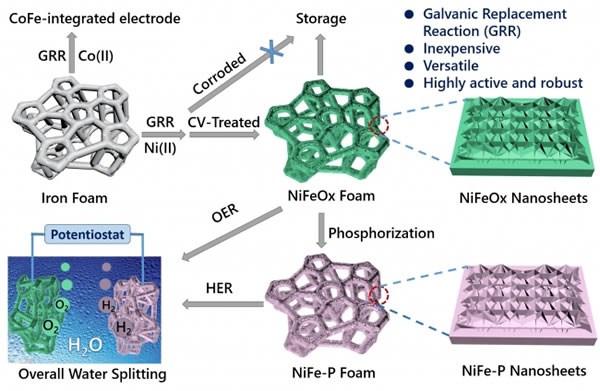Recently, Prof. Chen Zuofeng of the School of Chemical Science and Engineering of our university has made important progress in the field of electrocatalytic water decomposition research. It has provided a new preparation method and design concept for the construction of cheap, efficient, and stable new water oxidation electrocatalysts to reduce the electrolysis of hydrogen in aquatic products. The energy consumption provides a truly viable solution.
In the research and development of new energy sources, hydrogen has attracted much attention because of its many advantages such as high combustion calorific value, non-polluting products, and diversified utilization forms. Compared with the steam methane conversion method and the water gas method, the electrolysis method uses water as a raw material and is a clean and sustainable method for large-scale production of hydrogen. In the electrolysis water reaction, the half-reaction of water oxidation and oxygen evolution is relatively difficult to thermodynamically or kinetically reduce the half reaction of hydrogen evolution relative to water. It becomes the bottleneck of the energy conversion efficiency of the entire water decomposition system, and the electrolysis water is increased. Energy consumption. The development of water oxidation catalysts based on inexpensive first transition metals is an important topic in the current study of water oxidation catalysis. Nickel-iron co-doped electrocatalysts, because of the synergistic effect of nickel-iron, are much more powerful than single metal-based catalysts and are one of the most promising electrocatalysts for water oxidation.
Recently, the research group of Professor Chen Zuofeng of our university reported a new method for preparing a nickel-iron-based catalyst electrode with a three-dimensional nanosheet structure using a spontaneous Galvaic Replacement Reaction (GRR) (see the following figure). The method utilizes the electrochemical potential difference between different metals as a reaction driving force, does not consume any energy, and has a simple preparation method. The catalyst electrode has a special three-dimensional nanosheet structure, and does not require the use of adhesives, and exhibits high water oxidation electrocatalytic performance and stability, requiring only 300 mV in a 1 M KOH solution with a current density of 1000 mA/cm2. Overpotential. This method has good scalability and is equally applicable to the preparation of cobalt-iron or even nickel-cobalt-iron ternary electrodes. Phosphating the prepared nickel-iron electrode can further prepare a nickel-iron phosphide hydrogen production catalyst with good catalytic performance. The two-electrode full-reaction electrolyzer assembled by the binary metal phosphide and the oxide exhibits good electrocatalytic water splitting performance. The results were published in the "Advanced Energy Materials", a well-known international material journal titled "Hierarchically Structured 3D Integrated Electrodes by Galvanic Replacement Reaction for Highly Efficient Water Splitting" (http://dx.doi.org/10.1002/aenm.201700107). (Influence factor 15.2). Wang Jianying, a doctoral student in the research group, was the first author of the dissertation.

Preparation of NiFeOx/iron foam and NiFe-P/iron foam electrodes and its application in the electrocatalytic decomposition of water
In another study of nickel-iron-based water oxidation catalysis, Prof. Chen Zuofeng and Wang Jianying also developed a new method for in-situ anode co-deposition of nickel-iron co-doped electrocatalysts, which gives the catalyst electrodes self-repair. The function overcomes the key problem of catalyst stability in the long-term electrolysis process. The research was published in the catalysing mainstream journal ACS Catalysis (2016, 6, 6987; impact factor 9.3) under the title “In Situ Rapid Formation of a Nickel-Iron-Based Electrocatalyst for Water Oxidationâ€.
The above research work was funded by the National Natural Science Foundation of China (21573160) and the Youth Fund Project (21405114).
We diviided the led light according to the using eviiroment. Most of our product is the commercial LED Lighting
Commercial lighting is a term used to describe lighting that is used in commercial spaces, including auto dealerships, distribution centers, churches, factories, offices, and warehouses. Unlike residential lighting, commercial lighting is made to withstand more abuse and has a longer lifespan.
While the focus of residential lighting is often on aesthetics, commercial lighting is task orientated. Commercial lighting systems are designed based on what the application is. For example, in an office-type setting, you may see task lighting, which illuminates specific areas where employees need concentrated light to be able to perform their jobs.
Cone Pendant Light,Cone Led Pendant Light,Hanging Lights For Living Room,Linear Pendant Lighting
Jiangmen Dilin Lighting High-Tech Co., Ltd. , https://www.jmdilinled.com